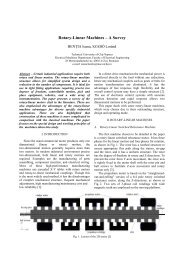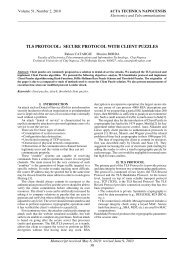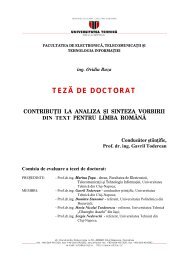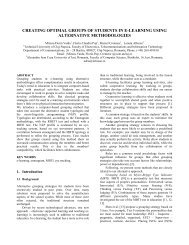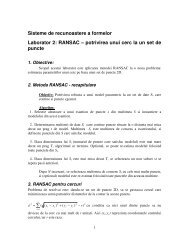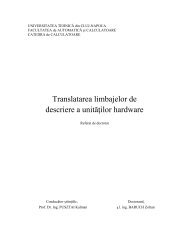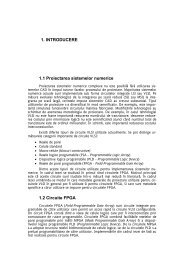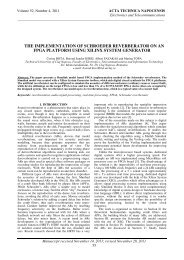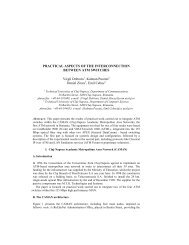LTE Emulator
LTE Emulator
LTE Emulator
Create successful ePaper yourself
Turn your PDF publications into a flip-book with our unique Google optimized e-Paper software.
<strong>LTE</strong> <strong>Emulator</strong> version 1.0 – technical report<br />
each user, but it has to be made in parallel for each user, by taking into account their<br />
characteristic parameters, since all users compete for the same limited radio resources. It is a<br />
complex process which establishes broadly the global transmission performances of all users<br />
allocated to a cell carrier.<br />
As for the priorities of the services associated to different users, the simulator allows the<br />
definition of a large number of services with different priorities in its interface (see paragraph 4.2.<br />
dedicated to description of the user’s parameters). Some significant examples of service classes,<br />
together with the imposed requirements (bit rate, delay tolerance, maximum bit error rate, etc.)<br />
are defined in [Win05_2]. The current version of the simulator – emulator employs a simpler<br />
approach, namely:<br />
o priority 0 (the highest) – telephony – low bit rate;<br />
o priority 1 – low bit rate streaming applications, e.g. medium quality voice and video<br />
applications;<br />
o priority 2 – high bit rate streaming applications, e.g. high quality voice and video<br />
applications;<br />
o priority 3 – file download – low and high bit rate – best effort type applications;<br />
Note: these categories of services constitute only examples of usual applications,<br />
the possible type of applications not being limited by the simulator.<br />
There are a lot of implementation solutions of the scheduler block [Lar04] [Yag04]<br />
[Win05_1] [Ste03], implementations which depend mainly on the characteristics of processing<br />
required by transmission, on the medium access technique, on the provided service classes and<br />
on the strategies used for service provisioning for different users. The scheduling algorithm<br />
implemented in the simulator allocates resources according to the priorities of the provided<br />
services and tries to ensure fairness between the users which have services with the same priority,<br />
even if they have different transmission bit rates.<br />
The operating principle of the implemented scheduler is briefly described bellow:<br />
o each user application is characterized, within each TTI interval, by an average bit rate, rM,<br />
and by an instantaneous bit rate, ri. The computed average bit rate rM must be equal to<br />
the average bit rate, dM, which characterizes the application, if there are sufficient radio<br />
resources available;<br />
o the average bit rate is recomputed in each TTI interval using the instantaneous bit rate of<br />
(N-1) previous TTI intervals and of the current TTI interval;<br />
o the desired instantaneous bit rate of the current interval is computed such that the<br />
computed average bit rate rM to be equal with the imposed average bit rate dM, according<br />
to (8).<br />
∑ − N 1<br />
rN<br />
−i<br />
i=<br />
1<br />
r = d ⋅ N −<br />
(8)<br />
N<br />
M<br />
where rN is the instantaneous bit rate to be provided in the current interval N, to ensure<br />
the imposed average bit rate, dM; rN-i denote the real instantaneous bit rate allocated in<br />
the previous N-i TTI intervals;<br />
o the computed (desired) instantaneous bit rate is replaced with the closest available bit<br />
rate, which can be obtained with the available transport frames and the current coding<br />
rate (the coding rate is modified by the HARQ process – see details in paragraph 5.2.<br />
related to the operations performed by the simulation program);<br />
o the transport frame obtained is mapped on the OFDMA chunks. If the mapping is not<br />
possible due to the lack of radio resources (available chunks), a smaller transport frame<br />
is used and the instantaneous bit rate, rN, is recomputed (reduced), providing in this way<br />
the real instantaneous bit rate in the current TTI interval N;<br />
o the allocation of the chunks to a certain user is performed according to the Best<br />
25



